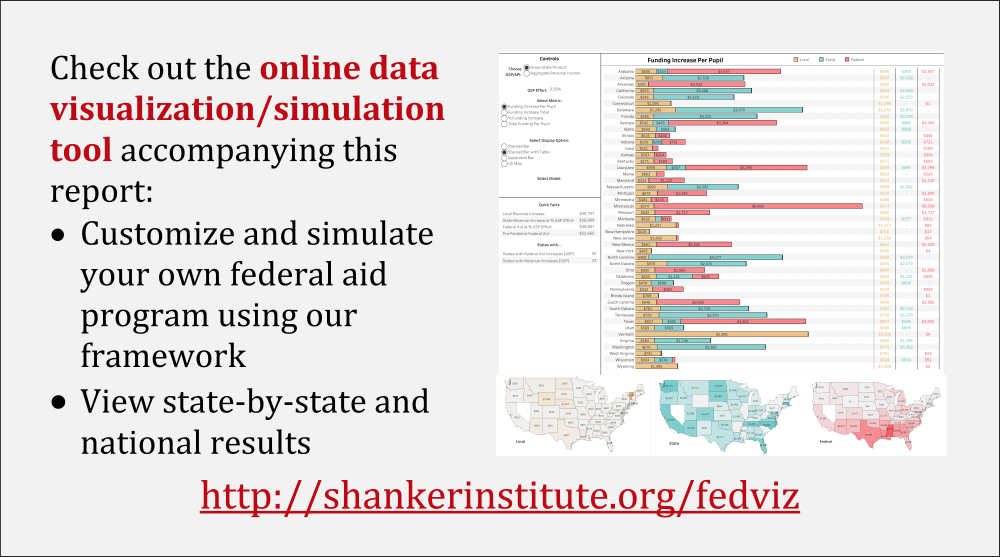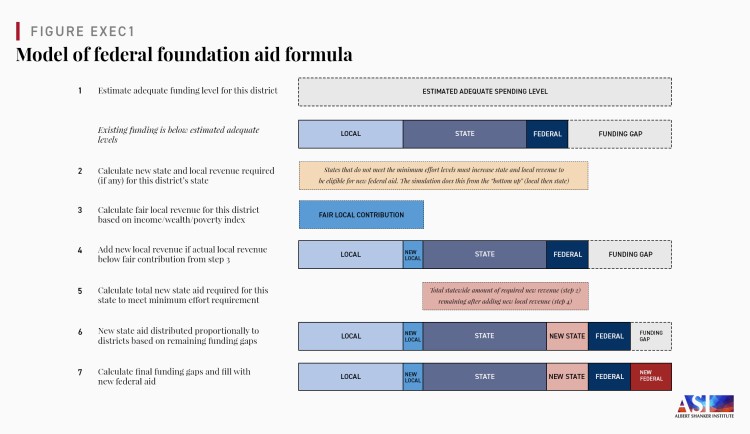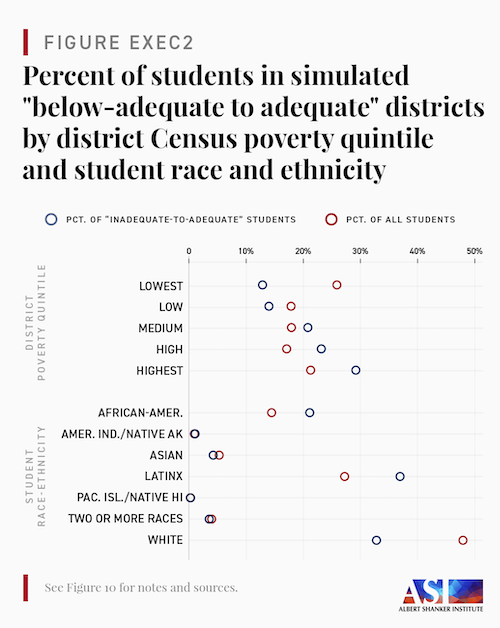Ensuring Adequate Education Funding For All: A New Federal Foundation Aid Formula

Executive Summary
In this report, we propose and simulate a framework for a new foundation formula approach to distributing federal K-12 education aid. This proposal, with full funding and compliance, would provide every school district with the estimated revenues necessary to reach the goal of average national outcomes in mathematics and reading. The framework is designed to target assistance where it is most needed by allocating federal funds based not only on student need (as is currently the case), but also on states’ and school districts’ ability (and willingness) to contribute themselves, given their capacity to raise revenue—in other words, based on their “effort.”
Some form of this “foundation funding” system is how state and local K-12 funds are distributed in almost all states, at least in theory (though often not in practice). States determine how much each district requires to meet the needs of its students—i.e., a “foundation” funding amount (adjusted for student characteristics). Districts are then expected to contribute a reasonable amount of local revenue toward these costs, given their capacity to raise those funds (e.g., a wealthy suburban district will raise far more revenue than a low-income city district at the same tax rate). Finally, state aid makes up the difference between this local “fair share” contribution and the minimum “foundation” total funding level.

Unfortunately, insufficient state revenue, the use of empirically invalid methods for calculating “foundation” funding levels, and other factors are responsible for the failure of this approach to provide adequate and equitable funding in most states. But the general idea of distributing funds based on needs/costs and effort/capacity is a sound approach, particularly in the United States, where nested jurisdictions with varying costs and resources share responsibility for public school funding.
In contrast, the vast majority of federal education aid is allocated based solely on student need/costs—or, more accurately, proxies for need, such as Census poverty rates in the case of Title I aid. So long as states maintain a certain percentage of their total funding levels between years, they get the same amount of federal aid regardless of effort.
As relates solely to student need, this is a fair approach to incorporating federal aid into the multilayered system of K-12 school finance in the United States. It is, however, also “effort neutral”— it fails to target crucial aid at states with smaller economies and high costs, which, despite their strong effort levels, cannot possibly meet their students’ needs. Conversely, it effectively rewards states that fail to provide adequate funding for all students, despite having the capacity to do so. A federal aid system based on a foundation formula would account for both factors: student need and the capacity of states and districts to raise revenues.
The proposal and simulation
We propose a framework for a new federal aid program that functions similarly to how state finance systems work (or, at least, how they are supposed to work)—that is, by distributing federal aid based on both costs/need as well as states’ and districts’ ability and willingness to pay their “fair shares” of the costs of bringing all districts up to a minimum adequate level. In this sense, our proposal integrates the federal government as the “top layer” in a national foundation formula, in which each level of government fills the gaps that the lower levels—state and local governments—cannot reasonably fill themselves, given their costs and capacities.
The simulation, which serves as a “proof of concept” for the framework, essentially builds out this national funding formula; the full details are laid out in the body of the report, but the process is summarized here. We begin by calculating adequate per-pupil funding levels for the vast majority of public school districts in the United States. This is accomplished using a national cost model that estimates the funding levels required to achieve the goal of national average math and reading scores, which we identify as a modest but reasonable common “benchmark” goal. Each district’s initial “adequate funding gap” is the difference between its current funding levels and these required adequate levels.
Filling all districts’ negative (inadequate) gaps—achieving universal adequate funding—is the primary end goal of our framework. Over half of all U.S. districts are funded below our estimated adequacy targets, and they are found throughout the nation. In many states, most students attend districts with below-adequate funding. But even in those (relatively few) states where most districts’ resources are above our adequacy targets, there are still many that fall through the cracks, and these school districts tend to be those with the highest costs and least capacity to pay those costs via local revenue.
Our simulation calculates the cost of bringing all of these inadequately funded districts up to their target levels. However, eligibility for these additional “gap-closing” federal funds are contingent upon states and districts contributing a reasonable “fair share” if they don’t already do so. We define this fair share contribution in terms of fiscal “effort”—i.e., total state and local K-12 revenue must constitute a minimum percentage of capacity (e.g., gross state product [GSP] or aggregate personal income [API]). This ensures that neither the federal government nor states with smaller economies (and/or very high costs) are required to bear a disproportionately large burden in meeting the needs of their student populations, particularly when localities aren’t contributing enough themselves.
In our proposal and simulation, we set this minimum effort level at roughly the U.S. average. Districts in states that meet this requirement are eligible for additional federal aid. And, indeed, about 20 states are “pre-eligible.” States, in contrast, that are below required effort levels must increase investment—at least gradually, demonstrating sufficient progress. For some states, this would require a moderate increase in revenue; for others, it would be larger.
We suggest that these latter states should have the flexibility to satisfy the overall requirement via some combination of increased state aid and/or increases in local revenue. In our simulation, however, this state/local split is determined from the “bottom up.” That is, we calculate reasonable minimum local revenue levels for all U.S. school districts, and any districts in which actual local revenue is below these minimums must increase local revenue to meet the targets (many districts already meet the minimum, while others do not). The minimum revenue amounts are based on a national local capacity index that we construct using measures of property value, income, and income-to-poverty ratios.

The final step is to simulate the allocation of new local, state, and federal aid. This procedure entails several sub-steps, models, and tests, but put simply, a combination of new state aid and new local revenue brings states up to the minimum required “fair share” effort levels (if they are not at those levels already), distributing the new funding to districts proportionally to their negative adequate funding gaps. Any district in which this new revenue is insufficient to raise total funding up to adequate levels receives new federal aid to make up the difference. See Figure Exec1 for a simplified illustration of the procedure for a hypothetical district.
Results of the simulation
Our proposed supplemental federal aid program is essentially voluntary for states. Those below minimum effort levels must boost investment, at least gradually, in order to be eligible. That said, in this summary we report national results of our simulation under a scenario of full compliance (state-by-state results are presented in the report). These national results, whether in this summary or below, represent maximum possible estimates of costs—as well as benefits—in the districts we are able to include in our models and simulation (which serve approximately 95 percent of all public school students).
Key national findings of the simulation include:
Universal adequacy would require roughly $52 billion in additional federal funding annually. Existing (pre-pandemic) federal aid, which constitutes around 10 percent of all K-12 revenue, would roughly double in our full compliance simulation. Yet this increase in federal funds would be accompanied by additional “fair share” state and local investment of approximately $80 billion, which is an aggregate increase of about 13 percent in total state and local revenue for fiscal year 2019. These increases vary widely by state, depending on current effort levels.
The additional federal funds would be targeted at districts in 34 states. These states (and districts) are those that cannot achieve adequate funding despite meeting minimum state and local effort levels. 18 states are “pre-eligible”—i.e., they would not have to increase state and local revenue to be eligible for new federal funds.
Full participation in this program would cause a decrease in the percentage of students in inadequately funded districts from about 55 percent to 0 percent. In other words, if all states increased state and local investment up to our target “fair share” levels, and roughly $52 billion in new federal aid filled the remaining adequacy gaps, around 26 million schoolchildren would no longer attend schools in inadequately funded districts. These “beneficiaries” and the districts in which they attend schools are a diverse group, as inadequate funding is a widespread problem. But a disproportionate share of our proposal’s beneficiaries attend schools in higher-poverty districts, and almost 60 percent are African American and Latinx students, who make up just over 40 percent of all students in our simulation (see Figure Exec2).

Full participation would also reduce the overall unequal opportunity gap—the average difference in adequate funding gaps between the highest- and lowest-poverty districts in each state—by over 60 percent. On average, the 20 percent of districts in each state with the lowest Census poverty rates are funded approximately $3,400 per pupil above estimated adequate levels. In contrast, the highest-poverty districts are funded roughly at an equal amount below adequate levels, for a total “unequal opportunity gap” of just over $6,700 per pupil. Our proposed framework, with all states meeting minimum effort levels and additional federal funds filling adequate funding holes, would reduce that gap to $2,638 per pupil, a decrease of about 61 percent. In addition, the program would reduce the national opportunity gap between African American and white students by 59 percent, while the Latinx/white gap would decline by 49 percent. In several states, such long-standing poverty- and race-/ethnicity-based funding gaps would be largely eliminated.
These improvements in opportunity gaps, like the distribution of “beneficiaries” by district poverty and student race and ethnicity, would stem from the targeting of new aid, especially federal and state aid, at districts funded below estimated adequate levels, which also tend to be those with higher poverty rates and larger shares of students of color. But, again, the benefits would be shared by a diverse group of districts and students, because inadequate funding is a widespread problem.
We emphasize that several of the important features of our proposal and simulation, such as minimum required “fair share” effort levels and the selection of the student outcome “benchmark” for adequate funding targets, are flexible. We have chosen parameters that we believe are reasonable and attainable, and we have made an effort to test and present separate results for different possibilities (e.g., different definitions of capacity in our effort measure). The actual design and implementation of our framework might require changes, and we believe it is flexible enough to meet these challenges. In addition, users can see results for different scenarios, including different minimum state and local effort levels, using the online data visualization tool accompanying this report.
***
The framework we lay out in this report is, most basically, a proposal for a new federal aid program, though this approach could also be used to allocate existing federal aid. Its most important benefits, of course, would be the improvement in student outcomes from more adequate and equitable funding in participating states. By bringing effort and capacity into the federal aid equation, as is the case in virtually all states’ systems, our framework ensures that the new federal funding goes where it is needed most.
Yet the framework is also designed with the longer-term goal of improving and “harmonizing” K-12 school finance at the state and local levels. While a handful of states’ finance systems do a reasonably good job of providing adequate funding for all students, most do not. Insofar as roughly 90 percent of all K-12 revenue comes from state and local sources, any serious effort to improve this situation will require substantial additional investment from states and districts. The federal government cannot compel such investment directly, but it can play a crucial role in helping the students most in need, while also incentivizing new state and local investment by rewarding states that contribute a reasonable fair share of their resources to public schools.
Resources
- Full report (or view in window below)
- One-page fact sheet
- Executive summary
- Online data visualization
CORRECTION (February 2013): In the original publication of the full report, two of the category labels in the legend of Figure 11 were accidentally transposed. This has been corrected. We apologize for the error.
Documents
